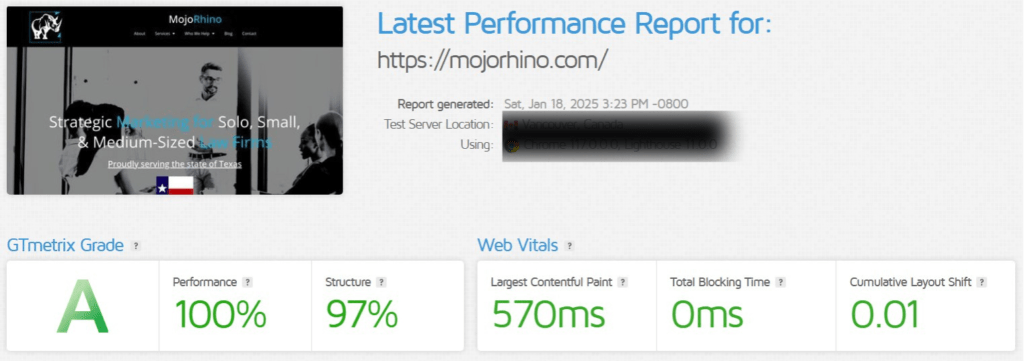Master SEO for Law Firms in Texas to Drive More Clients to Your Website
- By MojoRhino - Dylan
For law firms, your website is your portal to profitability.
So, having a website that’s A-level optimized for search engines is critical for your firm’s success.
Thing is, though, SEO is the component of the high-traffic mix that’s often most neglected by law firms.
Why is this?
Because many law firms view SEO as highly technical and too difficult to learn and implement.
This is a huge mistake.
SEO is totally learnable and implementable, and even law firms that aren’t tech-savvy and are strapped for time or money can learn to nail it and start driving more targeted traffic to your site.
And more traffic → more opportunity → more success.
So, here’s how to master SEO for law firms in Texas to improve your website’s SEO and rank higher in Google’s search results.
Keyword Research:
The Foundation of SEO for Texas Attorneys
If you want to get the best results from your SEO, doing keyword research is critical.
Keyword research is the process of identifying the most relevant words and phrases your target market types into the major search engines to find the most accurate information they’re looking for.
And the purpose of thoroughly researching keywords is so you can write your website’s content to match whatever your prospective clients plug into Google (we’ll focus on Google specifically because it owns approximately 83% of the search engine market).
The more closely your site’s content matches your target market’s queries, the better you’ll rank in the results.
According to HubSpot, there are three main elements of keyword research: Relevance, Authority, and Volume.
Relevance, Authority, and Volume:
The Keys to Effective SEO
Relevance
Relevance equates to search intent, and Google ranks for relevancy because they focus on providing the best match for their users’ searches.
Which means, the closer your content meets the searchers’ intent, the higher you’ll appear in the results.
Authority
The more Google deems you an authority on the subject-matter of your content, the better that content will perform in search queries.
And the reason this is important is because it’s in your best interest as a law firm to research SEO keywords that fit your evidenced expertise. Especially keywords that aren’t already dominated high-authority sites with huge traffic.
Competition there is insane, especially if you’re just starting out as a solo or small firm.
Volume
According to HubSpot, “Volume is measured by MSV (monthly search volume), which means the number of times the keyword is searched per month across all channels.”
So, the more that people search for your keyword, the higher the potential traffic to your website.
The key here is to identify keywords within your subject-matter that have high interest to your target audience but aren’t already dominated by the highest-authority sites.
Once you’ve gained consistent traffic within your area of specialization, you’ll be in a much better position to start competing for the more popular keywords.
Optimizing On-Page Elements
to Attract Texas Law Firm Clients
There are numerous on-page SEO elements, enough so that covering them all would warrant an entire article of its own.
But here are the five most important on-page SEO elements for law firms to get right if you want to improve your Google rankings.
Scannable Content for Your Law Firm’s Website
People tend to scan an article before they read it.
At least what’s showing above the fold (where the screen starts) and maybe a little below.
The reason is because they want to get a feel for how easy or difficult reading it might be.
If they feel it’ll be difficult to read, they’ll likely leave your site, which not only hurts conversions but Google frowns on it, too.
With Google, a positive user experience equals a good search result, meaning they did their job in delivering your page as an option to the user’s query. And a good search result means another happy customer who is likely to keep using their service.
The way Google sees it, the longer a visitor stays on your webpage, the happier they must be with its content.
So, make your content scannable by using:
- Descriptive headers
- Bulleted and numbered lists
- Short sentences and paragraphs
Readability for Attorney Websites
The next key element for on-page SEO is readability.
Optimizing for this is especially simple.
All it requires is choosing easy-to-read fonts, making sure there’s enough contrast between your background and text, and using simple words.
Limit your text to two fonts and use one of them exclusively for headings and the other for the body (Ex: This article uses Open Sans and Lato).
Next, ensure there’s visual contrast between your background and text colors (i.e., white lettering on a light gray background is more difficult to read than on a dark gray background).
And last, keep the language simple, as in eighth-grade-level simple.
The easier it is to read, the more likely it is to get read.
If you struggle with this, check out Hemingway App.

Hierarchal Headings: Structure Your Content Strategically
Hierarchal headings simply means using appropriately sized headings to indicate their importance within the piece of content.
The heading sizes are H1, H2, H3, H4, H5, and H6.
For example, in this blog post the main heading, “Nail Your SEO to Drive Traffic to Your Law Firm’s Website,” is an H1 (and there should only be one H1 in your entire article, and it should be the title of the article).
Then the titles of the main sections (i.e., “Optimize On-Page Elements”) are H2s. Within these main sections are subsections which use H3 headings (i.e., “Hierarchal Headings”).
And so on.
Pro Tip: Where possible, use your keywords in your headings, as this boosts SEO.
Keyword Count: Strategic Usage Without Overstuffing
Familiar with the term keyword stuffing?
It’s an old SEO black hat trick where people would stuff their content with their keyword so it occupied an overly appropriate amount of the text. And before Google figured out what was going on, it worked well.
Then came the algorithm change, and now if Google thinks you’re stuffing your content with keywords, then likely your rankings will be greatly diminished.
At this time, the optimal keyword ratio for ranking high on Google is < 2%.
So use your keywords sparingly but strategically (i.e., in headings), and substitute with synonyms when necessary.
Linking Strategies for Texas Law Firm Websites
Linking is simply hyperlinking text within your content to take the reader somewhere else for more information.
Two types of linking for on-page SEO are internal and outbound.
Internal Linking to Keep Visitors Engaged
Internal linking is when you link from one page of your website to another.
For example, say you wrote a blog post on understanding your personal injury rights, mentioned the different types of compensation, and then linked the words “reputation damage” to a previous blog post specifically about non-economic damages. This would be internal linking.
Outbound Linking to Build Authority
Outbound linking is when you link from content on your website to an external source, such as someone else’s blog post you’re citing from.
An example from this blog post would be when I linked to the HubSpot article in the fifth paragraph of the “Keyword Research” section, which takes you from this page to the HubSpot post.
If visitors like the content you’re linking to, internal links keep them on your website longer, which signals to Google that the user is having a good experience.
Outbound links show Google you’re trustworthy because you support your information by citing/linking to authority sources.
Why User-Friendly Website Design Is Critical
for Mastering SEO for Law Firms in Texas
Many people are surprised to learn that website design impacts Google search rankings.
This is because optimized UI (user interface) on a website makes it easier to navigate, and the easier it is to use, the more likely the visitor is to stay put instead of getting frustrated and heading to your competitor’s website.
Bad UI → high bounce rates.
High bounce rates → low rankings.
Here are the top three SEO elements to focus on for user-friendly website design:
Boosting Page Load Speed
The faster each page of your website loads when someone clicks to them either from search engine results, links on other sites, or internal links within your site, the better.
According to Think with Google, “The probability of bounce increases 32% as page load time goes from 1 second to 3 seconds.”
The best free tool for testing your website’s load time is GTmetrix.

Ensuring Mobile Friendliness
Mobile web use is already huge and growing more so every year.
Per Statista, “Mobile accounts for approximately half of web traffic worldwide. In the first quarter of 2023, mobile devices (excluding tablets) generated 58.33 percent of global website traffic, consistently hovering around the 50 percent mark since the beginning of 2017 before permanently surpassing it in 2020.”
This means that if your site is clunky on mobile devices, Google will send you to the end of the line.
Simplifying Navigation for Your Clients
Intuitive navigation means visitors can move around comfortably on your site because they know where they are, where they’re going, and how to easily get back to where they were.
The more intuitive the layout is, the likelier users are to stay on your site longer.
Which Google likes.
Download Your Free Ebook


